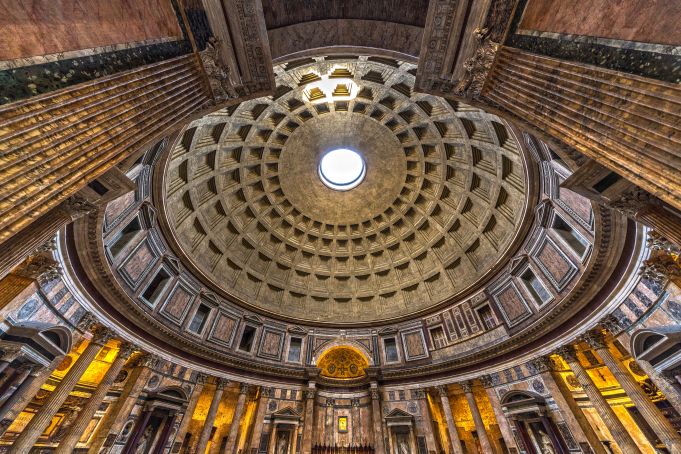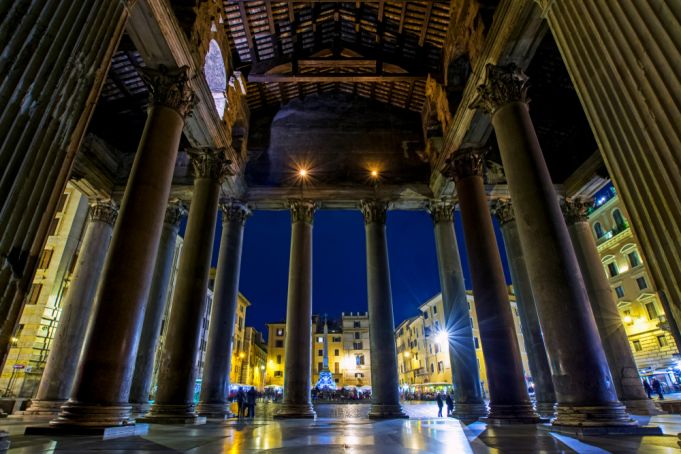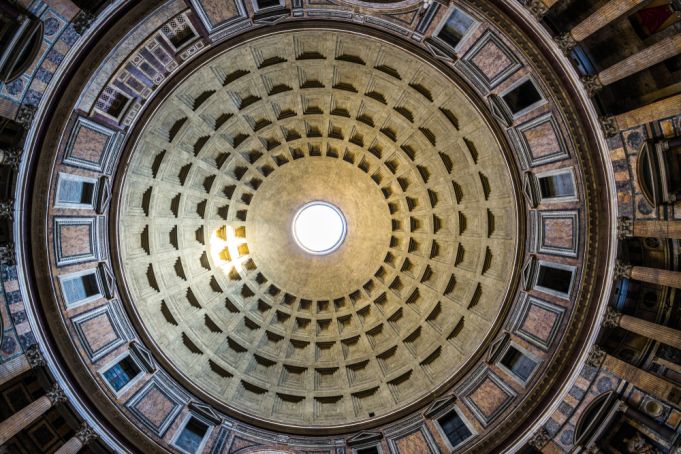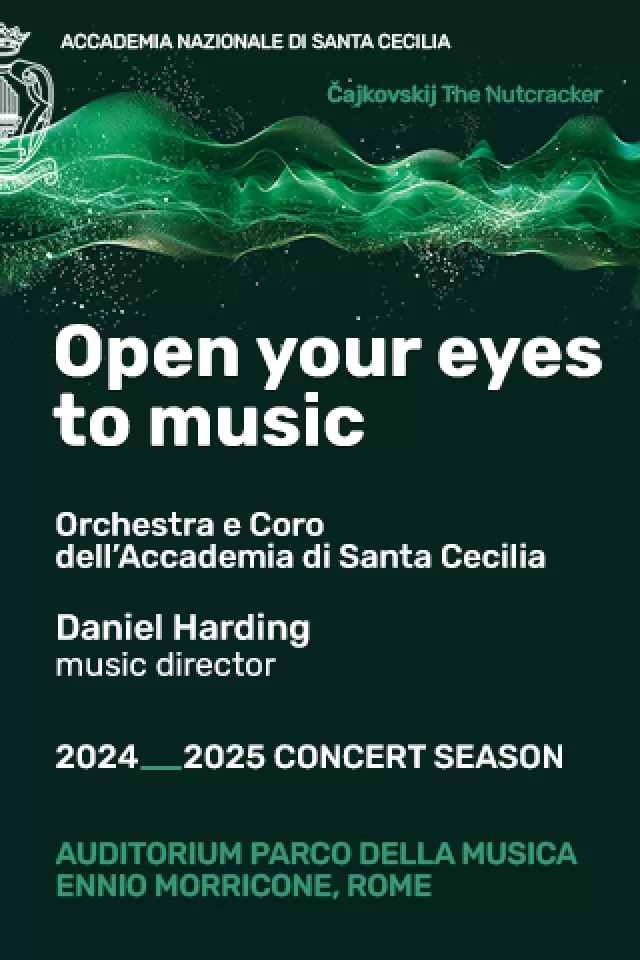Tracing some of the Pantheon's reincarnations down through the centuries.
In the quincentenary year of his death, Raphael can stake a claim as greatest artist ever.
So the Pantheon, whose interior he once, as it now seems, sketched prophetically and where he is buried might contest the title as world’s greatest building. For height the United States could vaunt any number of structures to surpass it. France, Dubai and Indonesia might cite their various towers, as, with some accidental help from nature, can Pisa.
Yet for sheer mass on the ground and the use (at least for its time) of cutting-edge technology and know-how the Pantheon must take the prize. Architects still puzzle over the dome’s construction. It would take over 1,300 years before Brunelleschi’s dome (1436) would equal it, while even today it keeps its record in the non-reinforced dome category.

‘When the Colosseum falls, Rome will fall, and when Rome falls, the world will perish.’ The proverb has not reckoned that, after such a hypothetical event, the perfectly proportioned Pantheon would in all likelihood still be there. Due to its sheer mass, but also to its form and symmetry. Not to mention its purpose, not for gory entertainment but, as Byron puts it, “a sanctuary and home/ of art and piety.”
Its interior corresponding to a sphere, ‘la Rotunna’, as it’s called fondly in Romanesco, from floor to the oculus matches with still astounding precision the diameter. Its 41 x 41 metres conjure a sense of space unprecedented in previous architecture, Egyptian, Greek or Etruscan.
Hadrian
“The likeness of a terrestrial globe and the stellar sphere,” is the way Hadrian puts it in Marguerite Youcenar’s novel Memoires d'Hadrien. Five levels of concentric caissons extend upward like the five then known planets. Horizontally, 28 per row, they match the moon’s annual cycles.
Symbolic but also relieving weight, the caissons take five steps backward to the wall, each originally embedded with a bronze star. To quote Shelley. “It is, as it were, the visible image of the universe.” Who knows whether with his simile in Adonais for life on earth, “like a dome of many-coloured glass”, he wasn’t thinking of this, its land-bound equivalent.
Michelangelo
Byron, in Childe Harold’s Pilgrimage heaps adjectives: “Simple, erect, severe, austere, sublime.” None is quite grand enough to fit. Michelangelo comments that the building seems the design of angels not men. Viewed from the exterior, the roof’s comparative flatness, like a convex pancake, is determined by the materials thinning out as the inner dome curves upwards, lest it collapse beneath its weight. Mixed in with the Pozzuolian cement, at the bottom are basalt blocks for strength, in the middle section knuckle-size bits of rock; at the top are lodged empty clay jars and pumice-stone, light enough to float in water.
Pyramids and Parthenon
Then, over time, there are the vagaries of history. Compared, the Pyramids remain stubbornly unchanged; the Parthenon comes down to us much diminished. The Pantheon seems, however, to have been blessed with several lives, a story of markedly different chapters, pantheons, one might say, plurality built in. Setting the cat among the architectural pigeons, Hadrian’s reconstructed version reproduced the wording on the original frieze, leading many to believe that “M. Agrippa fecit…”
Centuries of archaeological confusion were settled partly when repairs to the dome’s upper section in 1892 uncovered bricks with stamps dating to Hadrian. Except lower down other bricks would emerge, their stamps going back to Trajan, Hadrian’s predecessor. Was then the present structure designed by Hadrian or by Trajan’s favourite architect Apollonius of Damascus, subsequently exiled and some say executed on Hadrian’s orders after he rashly criticised design faults of Hadrian’s Temple of Venus in the Forum?
Agrippa
In one sense the frieze’s wording is true. Agrippa, Augustus’s son-in-law with a superhuman list of skill-sets – thrice-consul, politician, property magnate, engineer, governor (of Gaul), geographer, road-builder, etc – did ‘make’ an earlier Pantheon, destroyed by a fire, rebuilt under Domitian, then struck by lightning and burnt again in 110, leading many to suspect the gods weren’t happy. Agrippa’s building was long believed to be rectangular, its portico facing south.

Rushed to the scene, archaeologists confirmed existence of now clearly visible remains from Agrippa’s era: also present at earlier excavations in 1996/7 Paola Virgil interviewed by Italian newspaper La Repubblica explains: “We discovered that beneath the Pantheon lies another Pantheon. Everything fitted a symbolic plan, the Pantheon pointing not south, as once thought, but north towards Augustus’s mausoleum. The ancient travertine slabs are oriented in a line linking the two monuments.”
The sole difference between Hadrian’s and Agrippa’s entrance, she points out, are the columns, ten in Agrippa’s case, eight initially in Hadrian’s. Agrippa 63-12 BC, general and architect, was best friend and son-in-law of Augustus.
Pliny the Elder
Regarding the interior, Pliny the Elder mentions Mars, and then how the statue of Venus, up in her niche, sported the pearl earrings once worn by Cleopatra. Jewellery but also a war trophy. Agrippa had been Augustus’s crack admiral at the battle of Actium in 31 BC, defeating the combined forces of Mark Antony and Cleopatra.
The Pantheon, together with baths and a temple to Neptune was partly to celebrate that naval victory, which cleared the way for Octavius to become the first Roman emperor taking the name of Augustus. According Cassius Dio, a later historian, in the entrance niches stood a statue of deified Agrippa, another to his deified political master Augustus; rubbing shoulders with the gods within was the dynasty’s founder, the deified Julius Caesar.

Having married into the family, Agrippa shared in and propagated the gens Iulia’s propensity for self-deification. “Not out of rivalry or ambition on Agrippa’s part,” writes Cassius Dio, “but from loyalty to Augustus and his constant zeal for the public good.” Along with its alignment explained above, to help the deification process along, the building occupied the spot where, back when Campo Marzio would have been so much marshland, Romulus was reputedly taken up to heaven, assuming the form of tutelary god Quirinus. Look up above the inscription to ‘Agrippa fecit’ and the deification theme is indirectly evident in the holes on the marble, used, suggest some historians, to secure a bronze eagle, the bird of Jupiter.
Fall of Rome
With Rome’s fall in the fifth century, the Pantheon lapsed into two centuries’ of disuse. It might have remained a flooded ruin. Then in 608 the building was donated by Byzantine emperor Phocas (he of the solitary column in the Forum) to Pope Boniface IV. 28 cartloads of bones were brought in from the catacombs and to the singing of the Gloria the church of S. Maria ad Martyres was inaugurated. Pagan devils, goes one account, were sent shrieking through the oculus. This didn’t prevent another emperor, Constans II in 663 ripping off, in both senses, the gilded bronze from the outer roof to decorate his temple in Byzantium. Only you can’t take it with you: the booty was in turn robbed by pirates, while Constans died in Sicily at the hands of an assassin.
Markets
The Pantheon also suffered under the Avignon papacy (1309-1377) when it was converted to a fortress by Rome's belligerent Colonna and Orsini families. At one point the portico hosted a mediaeval poultry market, and as late as 1848 a fish market; those holes in the pillars were put there to support the awnings.
To make the building more churchlike, in 1270 a small bell tower was erected on the top of the gable but this was demolished under the pontificate of Urban VIII (1623-1644) who added two bell towers to either side of the façade. Often misattributed to Bernini, these towers did not seem to please the public eye, being named ‘Ass’s Ears,’ and were subsequently pulled down in 1883.
Raphael
With the Renaissance things improved. Brunelleschi, Michelangelo and Raphael (another papal architect) raised the building’s prestige. The latter not only made a sketch (now in the Uffizi); he chose it for his tomb, commissioning a statue from his pupil Lorenzotto, the Madonna of the stone, still there today. By the 19th century his burial had become a distant memory. Hence Pope Gregory XVI in 1833 ordered five days of excavations: an oaken but much soaked coffin was unearthed along with intact skeleton.
To adapt Belli’s Romanesco, ‘It’s him; no, it ain’t; ‘tis; ain’t – pell-mell;/ It’s Raphael; it’s not Raphael.’ A new pine coffin was made, this placed within an ancient sarcophagus bordered elegantly with Cardinal Bembo’s Latin epitaph: ‘Here’s one in whom Nature feared – faint at such vying -/Eclipse while he lived, and decease at his dying.’ (Alexander Pope’s translation.)
Kings
In further commemoration the cultural ministry recently laid a wreath at the same spot, flowers tagged with a rainbow and now familiar caption ‘Andrà tutto bene' (Everything will be all right). The Pantheon is also the final resting place of two Italian kings, Vittorio Emanuele, and Umberto I, along with the latter’s wife, Margarita of Savoy.
Meanwhile every spring equinox in time for Rome’s traditional birthday an ever-swelling beam descends from the oculus into the ‘massive cavern’. It moves across the walls to alight on and illuminate the inner doorway. The stone arch above gets transformed into another rainbow, this time silvery, phosphorescent, neon.
Like Byron one struggles for adjectives. A dome then, that not so much ‘stains the white radiance of eternity’ as concentrates it in a moment of brilliant apotheosis. As a symbol of survival in these covid-19 times, the Pantheon remains gracefully and monumentally resilient.
By Martin Bennett
This article was published in the online July-August 2020 edition of Wanted in Rome magazine.
General Info
View on Map
Rome's Pantheon: From Hadrian to Raphael
Piazza della Rotonda, 00186 Roma RM, Italy




















